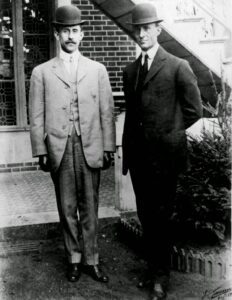
The Wright Brothers, Orville and Wilbur Wright, are often credited as the inventors of the world’s first successful powered, controlled, and sustained flight. Their groundbreaking achievements in aviation revolutionized transportation, technology, and the world as we know it. This blog post delves into the extraordinary contributions of the Wright Brothers to aviation, exploring their journey from bicycle mechanics to aviation pioneers.
Early Life and Background of the Wright Brothers
Orville and Wilbur Wright were born in Dayton, Ohio, in 1871 and 1867, respectively. Raised in a family that valued education and innovation, the brothers had a strong foundation in mechanics and engineering from a young age. Their father, Milton Wright, was a bishop, and their mother, Susan Koerner Wright, encouraged curiosity and experimentation.
A Fascination with Flight
The Wright Brothers’ fascination with flight began when they were exposed to various flying machines, including kites and gliders, during their childhood. They were particularly inspired by the work of aviation pioneers like Octave Chanute and Otto Lilienthal, whose research on the principles of flight laid the groundwork for the Wrights’ own experiments.
Experimental Beginnings
The Wright Brothers started their journey towards powered flight by opening a bicycle sales and repair shop in Dayton. Their work on bicycles allowed them to gain practical experience in mechanics and engineering, skills that would prove invaluable in their aviation endeavors. They soon turned their attention to flight.
Key Innovations of the Wright Brothers
a. Three-Axis Control: One of the most critical contributions made by the Wright Brothers was the development of a three-axis control system. They realized that maintaining balance and stability in flight required control over the pitch, roll, and yaw of the aircraft. To achieve this, they created a system of wing-warping and a movable rudder, which allowed for precise control.
b. Wind Tunnel Testing: Prior to their powered flights, the Wright Brothers conducted extensive wind tunnel testing to refine their understanding of aerodynamics. This meticulous approach helped them design more efficient and controllable aircraft.
c. The First Powered Flight: On December 17, 1903, at Kitty Hawk, North Carolina, Orville Wright piloted the Wright Flyer for a historic 12-second flight, covering a distance of 120 feet. This momentous achievement marked the first successful powered flight in history.
“Wright Day” typically refers to December 17th, which is celebrated as Wright Brothers Day in the United States
This date commemorates the historic achievement of Orville and Wilbur Wright, who successfully conducted the world’s first powered, controlled, and sustained flight on December 17, 1903, in Kitty Hawk, North Carolina. Wright Brothers Day is an annual observance that honors their pioneering contributions to aviation and their groundbreaking achievement in making powered flight a reality.
Each year on Wright Brothers Day, aviation enthusiasts, history buffs, and the general public come together to remember the Wright Brothers’ monumental accomplishment and their profound impact on the world of aviation. It serves as a reminder of the innovation and determination that led to the development of modern aircraft and the advancement of human flight. Various events and activities, such as educational programs, museum exhibits, and aviation-themed celebrations, are often organized on this day to honor the Wright Brothers’ legacy.
Further Advancements
After their initial success, the Wright Brothers continued to refine their aircraft and aviation technology. They made longer and more controlled flights, ultimately leading to their Flyer III, which could remain airborne for over an hour.
Legacy and Impact
The contributions of the Wright Brothers to aviation are immeasurable. Their achievements paved the way for rapid advancements in aviation technology and the birth of the aerospace industry. Their innovative three-axis control system became the foundation for modern aircraft design. Moreover, their work influenced countless future aviators and engineers, inspiring generations to pursue careers in aviation.
Wrapping it Up
The Wright Brothers’ contributions to aviation were nothing short of revolutionary. Through their determination, meticulous research, and innovative thinking, they unlocked the secrets of powered, controlled flight. Their groundbreaking achievements not only changed the way we travel but also opened up new possibilities for exploration, commerce, and global connectivity. The legacy of Orville and Wilbur Wright continues to soar high in the skies, reminding us of the power of human ingenuity and the endless possibilities of the human spirit. That’s it until next time and remember to Be Social, Fly Private!

